#Rails development in Ukraine
Explore tagged Tumblr posts
Text
Things Biden and the Democrats did, this week #26
July 5-12 2024
The IRS announced it had managed to collect $1 billion in back taxes from high-wealth tax cheats. The program focused on persons with more than $1 million in yearly income who owned more than $250,000 in unpaid taxes. Thanks to money in Biden's 2022 Inflation Reduction Act the IRS is able to undertake more enforcement against rich tax cheats after years of Republicans cutting the agency's budget, which they hope to do again if they win power again.
The Biden administration announced a $244 million dollar investment in the federal government’s registered apprenticeship program. This marks the largest investment in the program's history with grants going out to 52 programs in 32 states. The President is focused on getting well paying blue collar opportunities to people and more people are taking part in the apprenticeship program than ever before. Republican pledge to cut it, even as employers struggle to find qualified workers.
The Department of Transportation announced the largest single project in the department's history, $11 billion dollars in grants for the The Hudson River Tunnel. Part of the $66 billion the Biden Administration has invested in our rail system the tunnel, the most complex Infrastructure project in the nation would link New York and New Jersey by rail under the Hudson. Once finished it's believed it'll impact 20% of the American economy by improving and speeding connection throughout the Northeast.
The Department of Energy announced $1.7 billion to save auto worker's jobs and convert factories to electronic vehicles. The Biden administration will used the money to save or reopen factories in Michigan, Ohio, Pennsylvania, Georgia, Illinois, Indiana, Maryland, and Virginia and retool them to make electric cars. The project will save 15,000 skilled union worker jobs, and created 2,900 new high-quality jobs.
The Department of Housing and Urban Development reached a settlement with The Appraisal Foundation over racial discrimination. TAF is the organization responsible for setting standards and qualifications for real estate appraisers. The Bureau of Labor Statistics last year found that TAF was 94.7% White and 0.6% Black, making it the least racially diverse of the 800 occupations surveyed. Black and Latino home owners are far more likely to have their houses under valued than whites. Under the settlement with HUD TAF will have to take serious steps to increase diversity and remove structural barriers to diversity.
The Department of Justice disrupted an effort by the Russian government to influence public opinion through AI bots. The DoJ shut down nearly 1,000 twitter accounts that were linked to a Russian Bot farm. The bots used AI technology to not only generate tweets but also AI image faces for profile pictures. The effort seemed focused on boosting support for Russia's war against Ukraine and spread negative stories/impressions about Ukraine.
The Department of Transportation announces $1.5 billion to help local authorities buy made in America buses. 80% of the funding will go toward zero or low-emission technology, a part of the President's goal of reaching zero emissions by 2050. This is part of the $5 billion the DOT has spent over the last 3 years replacing aging buses with new cleaner technology.
President Biden with Canadian Prime Minster Justin Trudeau and Finnish President Alexander Stubb signed a new agreement on the arctic. The new trilateral agreement between the 3 NATO partners, known as the ICE Pact, will boost production of ice breaking ships, the 3 plan to build as many as 90 between them in the coming years. The alliance hopes to be a counter weight to China's current dominance in the ice breaker market and help western allies respond to Russia's aggressive push into the arctic waters.
The Department of Transportation announced $1.1 billion for greater rail safety. The program seeks to, where ever possible, eliminate rail crossings, thus removing the dangers and inconvenience to communities divided by rail lines. It will also help update and improve safety measures at rail crossings.
The Department of the Interior announced $120 million to help tribal communities prepare for climate disasters. This funding is part of half a billion dollars the Biden administration has spent to help tribes build climate resilience, which itself is part of a $50 billion dollar effort to build climate resilience across the nation. This funding will help support drought measures, wildland fire mitigation, community-driven relocation, managed retreat, protect-in-place efforts, and ocean and coastal management.
The USDA announced $100 million in additional funds to help feed low income kids over the summer. Known as "SUN Bucks" or "Summer EBT" the new Biden program grants the families of kids who qualify for free meals at school $120 dollars pre-child for groceries. This comes on top of the traditional SUN Meals program which offers school meals to qualifying children over the summer, as well as the new under President Biden SUN Meals To-Go program which is now offering delivery of meals to low-income children in rural areas. This grant is meant to help local governments build up the Infrastructure to support and distribute SUN Bucks. If fully implemented SUN Bucks could help 30 million kids, but many Republican governors have refused the funding.
USAID announced its giving $100 million to the UN World Food Program to deliver urgently needed food assistance in Gaza. This will bring the total humanitarian aid given by the US to the Palestinian people since the war started in October 2023 to $774 million, the single largest donor nation. President Biden at his press conference last night said that Israel and Hamas have agreed in principle to a ceasefire deal that will end the war and release the hostages. US negotiators are working to close the final gaps between the two sides and end the war.
The Senate confirmed Nancy Maldonado to serve as a Judge on the Seventh Circuit Court of Appeals. Judge Maldonado is the 202nd federal Judge appointed by President Biden to be confirmed. She will the first Latino judge to ever serve on the 7th Circuit which covers Illinois, Indiana, and Wisconsin.
Bonus: At the NATO summit in Washington DC President Biden joined 32 allies in the Ukraine compact. Allies from Japan to Iceland confirmed their support for Ukraine and deepening their commitments to building Ukraine's forces and keeping a free and Democratic Ukraine in the face of Russian aggression. World leaders such as British Prime Minster Keir Starmer, German Chancellor Olaf Scholz, French President Emmanuel Macron, and Ukrainian President Volodymyr Zelenskyy, praised President Biden's experience and leadership during the NATO summit
#Joe Biden#Thanks Biden#politics#us politics#american politics#election 2024#tax the rich#climate change#climate action#food insecurity#poverty#NATO#Ukraine#Gaza#Russia#Russian interference
3K notes
·
View notes
Text
No Pope had ever kissed the feet of leaders, begging them to bring peace to their country. But in April 2019, Pope Francis surprised South Sudan and the entire world when he did just that to President Salva Kiir, Vice President Riek Machar, James Wani Igga, Taban Deng Gai, and Rebecca Nyandeng De Mabior; a gesture that clearly expressed his belief that the Pontiff of the Catholic Church must be a committed and unwavering peacemaker.
Pope Francis spoke about peace until his very last breath. In his brief message before the Urbi et Orbi blessing on April 20, Easter Sunday, he mentioned peace 10 times, remembering the Holy Land and the gift of all Christians celebrating Easter on the same day, in Lebanon, Syria, Yemen, Ukraine, the Southern Caucasus, the Balkans, Democratic Republic of the Congo, Sudan and South Sudan, the Sahel, the Horn of Africa and the Great Lakes region, and also Myanmar.
His memory of specific countries and regions was accompanied by his concern for freedom of religion, freedom of thought, freedom of expression, and respect for the views of others. He stressed that no peace is possible without true disarmament. The call was “to care for one another, to increase our mutual solidarity, and to work for the integral development of each human person.”
5 notes
·
View notes
Text
GE PowerHaul
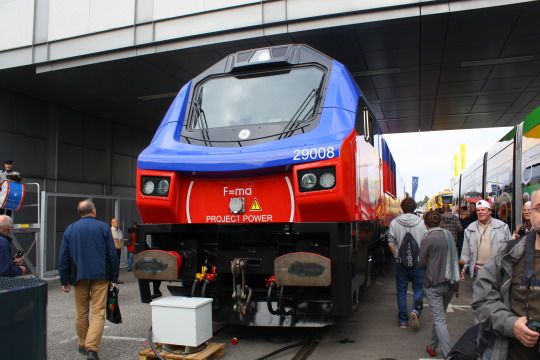
After I offered, @valtionrautatiet-official asked me to post some pictures of the locomotive that is nowadays known as the Dr20, used by the private freight operator North Rail in Finland. Here it is in 2012, long before anyone ever even considered sending it to Finland, in Berlin. The reason that it's in Berlin specifically is that it's at Innotrans, the biggest trade fair and exhibition for railroads that exists. At this point it had the paint job of HHPI (Heavy Haul Power International, despite the important sounding name really just one of many European freight rail companies with headquarters in Germany), with their trademark blue and red and their company policy of putting Newton's second law on it. "Project Power" also sounds cool, doesn't it? Well, it turns out they never entered service for HHPI. Way too much history under the cut.
The story behind these eight locomotives is weird and opaque, and there is a lot of stuff we may never know, but on a very fundamental level it seems to be one of the victims of what I call the six-axle diesel curse. This basic of that theory of mine is that it's impossible to sell big, heavy, powerful diesel locomotives, the kind that are so powerful that they need six axles for all the weight from their big engine and diesel tank, in (West) Germany and to a certain extent central and Western Europe, at least nowadays, unless you do it by accident.
The German locomotive industry has wanted to build big six-axle diesel locomotives since the end of steam traction. There was a prototype six-axle version of the V 200, named V 300, in the 1950s, but DB didn't want it (a related but less powerful version was sold to Yugoslavia to haul Tito's private train). For the Americans here, the Krauss-Maffei locomotives of the Southern Pacific and Rio Grande were related to that.
A few years later, in 1962, we get the V 320, a six-axle version of the V 160 locomotive family. The four-axle version was very popular and is still in service, but they only built the prototype of the six-axle version. Interestingly, that one prototype is still around as well, hauling construction trains. Deutsche Bahn was never interested, they preferred the flexibility of having more smaller units. And anyway, they were busy electrifying the busy main lines that would have made the most use of those heavy machines.
In the 1970s Henschel and BBC (the electric equipment one, not the British TV one) built three copies of the DE 2500 both with four and six axles, but those were really more experimental machines.
In the late 1980s and early 1990s, MaK tried to sell their DE 1024, and I actually have a picture of that ne.
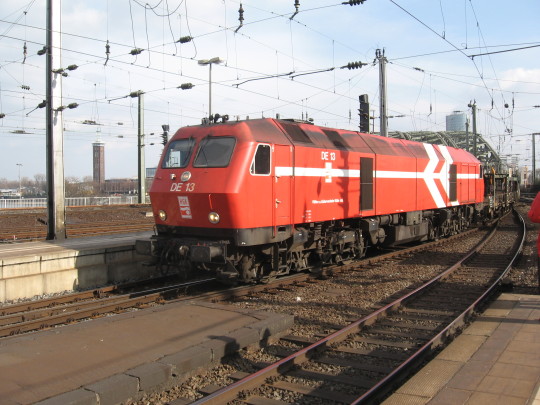
They built three prototypes, and Deutsche Bahn seemed to genuinely toy with the idea… but in the end it was decided to electrify the lines in the (mostly flat) north that hadn't been electrified yet anyway.
And at the same time, the wall fell, and suddenly Germany had access to all the locomotives of the east, now mostly surplus since mostly the industry they served did not survive the transition to western markets. East Germany had bought powerful six-axle diesel locomotives in enormous numbers from the Soviet Union, specifically modern-day Ukraine, and those were available, good enough and already paid for. In particular the class 232 and related, known as "Ludmilla" among rail fans, have proven very useful.
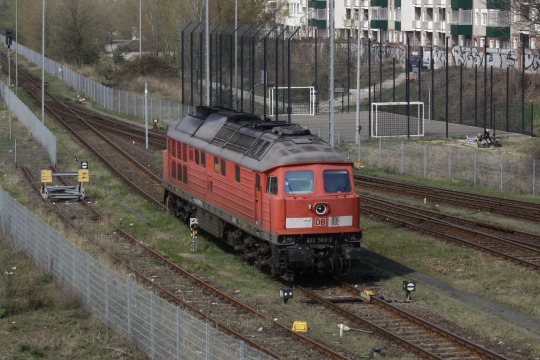
MaK was able to sell an altered version of that locomotive to Norway, but that turned out to be be a huge disaster as they developed a habit of catching on fire. Eventually Siemens (who briefly owned MaK) had to take them back, and since then they've changed hands an astonishing number of times - apparently right now Hector Rail and RDC Autozug have a lot of them. Here's one in Hamburg Altona when it was used on regional trains there.

The three prototypes went to locally owned operator HGK, where two of them also burned down. DB probably dodged a bullet there. Interestingly enough, the only one that didn't burn down was number 13, but that was finally scrapped a few years ago.
In the mid-1990s, ADtranz (later Bombardier) and GE got together to build the Blue Tiger locomotive, a very distinctive-looking and noisy machine. They sold 11 to various private operators in Germany, 30 to Pakistan and 20 to Malaysia. Not terrible, but not a huge success either.
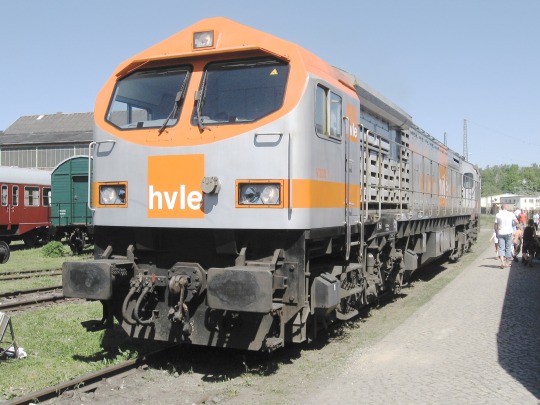
But in the 2000s, things were changing. Liberalisation meant that more and more companies were running services all throughout Europe. The busy main lines were electrified, but many of the border crossings weren't yet, so there was a new need for big six-axle diesel locomotives.
The big beneficiary of this was EMD from North America, who were already supplying such locomotives to Great Britain. The rail companies there needed these machines to replace unreliable British-built power, and to replace environmentally friendly electric locomotives, because most of the British network is not electrified and the few sections that are have way too much traffic on them.
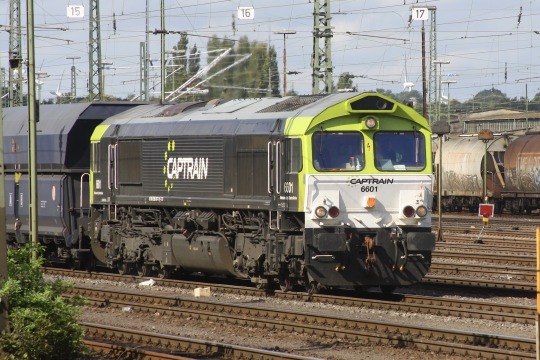
The Class 66 is an ugly mess, designed by figuratively building a metal shed in the inside of a tiny British rail tunnel. It's so noisy that drivers in Norway get hazard pay for being in them. But it works and it was mass produced, and a lot of them made their way to the continent in short order.
Other companies wanted in on that business. Voith decided to enter locomotive building after previously supplying traction equipment. They had high hopes for their Maxima series of locomotives, which they started building in 2008, and they had their own leasing company. They did a lot of marketing and the machine won prestigious design awards.

At one point they had a hundred pre-orders. In the end their own leasing company folded, and they only built twenty, which they didn't even manage to sell that quickly. Nowadays they've stopped producing locomotives again.
General Electric, the other North American locomotive company, wanted in on that action as well. Sure, it hadn't worked with the Blue Tiger, but years had passed and things were different now. For their new product, the PowerHaul, they decided to follow what EMD had done. They started with the class 77 for the British market, first shown at Innotrans in 2010.

Then they wanted to work their way out to wider Europe, with a special continental version that was designed with a bigger shell to match the larger tunnels on the continent. That way they weren't quite as cramped. EMD had considered a similar idea, a European-sized class 66, but decided against that.
GE also did not intend to make them themselves. Instead after the initial batch of British 77s, they transferred production to their Turkish partner Tülomsaş, who supplied some more British ones and the ones for central Europe. 29008 is one of them.
In the end all of these plans fell through. A lot of the international border crossings did get electrified much quicker than the diesel sellers had hoped. The one near where I live, the Montzenroute, started electric running in December of 2008, and it was actually the makers of electric locomotives who made bank off of the new international railway world. Here is a Bombardier TRAXX electric locomotive during the first week that freight trains from Germany to Belgium were running with electric power, just a few hundred meters from the border.
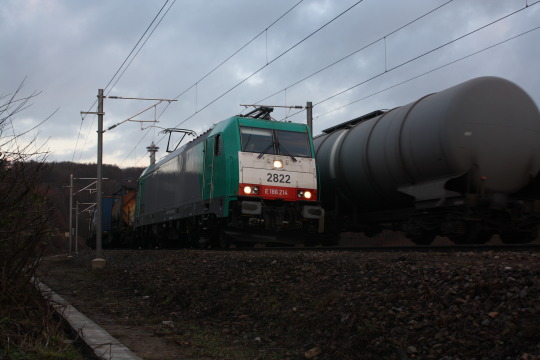
But the business changing is one thing, the story of the PowerHauls seems to be even more complicated. After all, GE did have a launch customer for their PowerHaul, in the form of HHPI. The locomotives were built, painted in HHPI colors, and tested. And then… well, nothing. They never entered service, instead sitting for years in Cottbus, Germany. I have no idea whether they ever got approved for service in Germany. Finnish Wikipedia says "HHPI had no use for them", but that sounds like a euphemism. Clearly HHPI had some use for powerful locomotives, they've recently taken delivery of some Stadler EuroDuals.
The EuroDual and the closely related Euro9000, pictured below, seem to be the solution to the six axle diesel curse though the conceptually simple but technologically difficult trick of simultaneously being a very powerful electric locomotive as well. They have already delivered more of them than Voith Maxima, GE Blue Tiger and GE PowerHaul combined. Sorry for the pictures, they don't park the locomotives well for good photos at Innotrans.
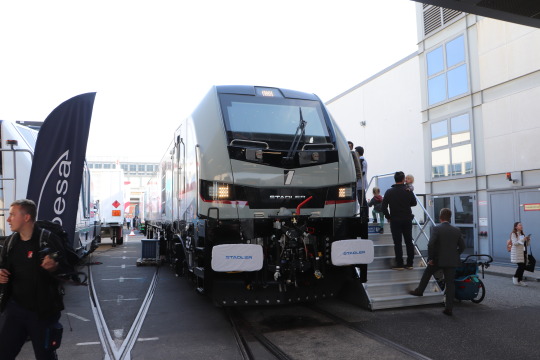
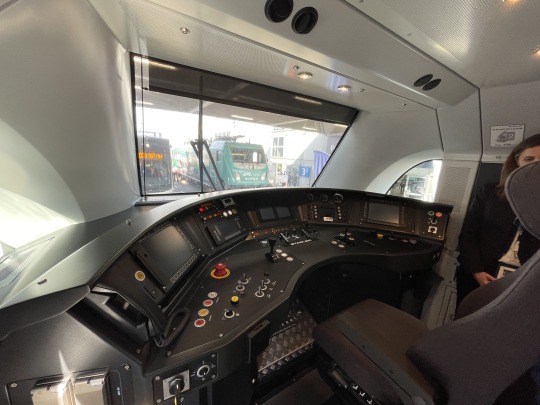
Also, GE was not able to find any customer in Germany, nor in Sweden, where some units of that type were tested at some point. Locomotives of that type were built for Turkey, though, and I haven't heard anything negative about them there. Those were also at Innotrans, in 2014.
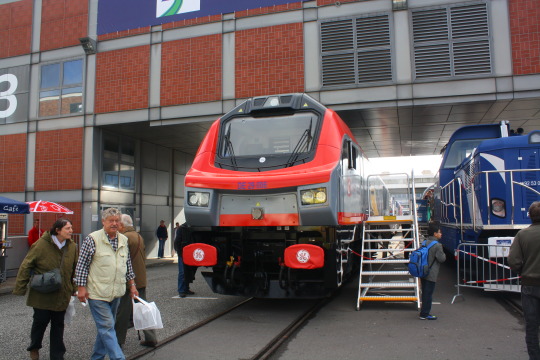
And then, years after everyone had forgotten about these machines, they suddenly turned up in Finland, in the hands of North Rail (formerly Operail), one of the few private companies there. That required at least new couplings, new axles (Finland has a different rail gauge, the measurement of how far the rails are apart), probably adjustments to the breaks, new train control systems and so on.
It's possible that North Rail was thoroughly convinced by the advantages of GE's concept or something, but I think it's far more likely that they just got a really good deal because GE was happy someone took them off their hands.
The reason they're in Finland is almost certainly that Operail needed some cheap machines that weren't doing anything, and these units were just that. But why were they not doing anything? Why were these machines doomed to sit in Cottbus for years, essentially still in new condition, painted for an operator that didn't want them? I'm sure you'll find plenty of theories if you look on online forums, and it's even possible that one of them is the truth, but unless some rail journalist decides to really dig into that, we'll probably never know for certain.
If you allow me to speculate: It certainly doesn't sound like a success story, and there have been all sorts of other stories where trains didn't get approval to run in the country they were ordered for, or had severe technical defects. Ask an Austrian rail fan about the Talent 3, a danish about the IC 4 or a dutch or Belgian about the Fyra to get some really fun rants. I don't know if these locomotives belong in that hall of shame, but it would certainly be an explanation.
My guess is that there won't be any more of these machines ever. GE Transportation doesn't even exist anymore, the whole part of the business got sold to Wabtec a few years ago. But if these machines are doing well in Finland now, good for them! Finally someone found something to do with these weird-looking units.
16 notes
·
View notes
Text
A House Democrat in the Congressional Hispanic Caucus (CHC) is breaking from the group to call for "tougher" border security measures after the ongoing migrant crisis forced U.S. officials to suspend railway operations between Texas and Mexico in two cities.
The statement by Rep. Henry Cuellar, D-Texas, whose district is anchored in Laredo, stands in stark contrast with the CHC’s position on the current border negotiations between Republicans and the White House.
Cuellar said rail operations were being stopped in Eagle Pass and El Paso on Monday morning so Customs and Border Patrol (CBP) could "redirect personnel to process migrants."
"The crisis at our border is seriously affecting legitimate trade," Cuellar wrote the evening prior. "This year alone, vehicle and rail operations have been suspended at multiple ports of entry due to an overwhelming number of migrants, worsening delays for truck drivers transporting goods and costing our economy millions."
He finished, "Our border communities desperately need more federal resources, and we need tougher measures at the border. We must secure the border now."
CBP accused smugglers of using freight trains to bring people into the U.S. illegally in a statement on Sunday night announcing the planned closures for Monday at 8 a.m. local time.
"CBP is continuing to surge all available resources to safely process migrants in response to increased levels of migrant encounters at the Southwest Border, fueled by smugglers peddling disinformation to prey on vulnerable individuals," the statement said.
"After observing a recent resurgence of smuggling organizations moving migrants through Mexico via freight trains, CBP is taking additional actions to surge personnel and address this concerning development, including in partnership with Mexican authorities."
It comes amid intense negotiations between Republicans and Democrats in both the White House and Senate over President Biden’s $110 billion supplemental aid package for Israel, Ukraine and other causes.
Republicans have made clear they would not consider Biden’s request unless it was tied to stricter border security and asylum measures.
The Congressional Hispanic Caucus, which is all-Democrat, released a statement last week urging Biden to show restraint in what he is willing to commit to in managing the border crisis.
"We are deeply concerned that the President would consider advancing Trump-era immigration policies that Democrats fought so hard against – and that he himself campaigned against – in exchange for aid to our allies that Republicans already support," they said. "Caving to demands for these permanent damaging policy changes as a ‘price to be paid’ for an unrelated one-time spending package would send a dangerous precedent."
7 notes
·
View notes
Text

🇷🇺🇺🇦 🚨 UPDATE ON THE RUSSO-UKRAINIAN WAR, OVERNIGHT ON DAY 619 INTO DAY 620
On the Political front:
President Zelensky is facing intense pressure from Ukraine's Western sponsors to hold elections next year, during which time it is apparent that the Western leaders supporting Ukraine will push for new leadership, with the hope of negotiating a ceasefire with the Russians in order to restock and reconstitute the Ukrainian Armed Forces before persisting with any further offensive operations in the East of Ukraine.
However, Lavrov, Peskov and Putin have all clearly stated that a ceasefire is NOT on the table, and any negotiated settlement agreed to by the Russians will require Ukrainian and Western acknowledgement that the regions of Ukraine taken by Russian Forces are now a constitutional part of the Russian Federation and acknowledgement of this by Ukraine and its allies will be a non-negotiable part of any political settlement.
It is unclear whether Ukraine, the United States or Ukraine's European allies understand how firm Russian officials are in this pledge, as they only seem to negotiate amongst themselves without including representatives of the Russian Federation.
In the Kherson direction:
In the area of Baryslav, Russian Forces were using FPV drones to disable a power station relay.
Meanwhile, heavy fighting is occuring in the area of the two Ukrainian footholds on the Left bank of the Dnieper, however with video evidence lacking, it is unclear what kind of operations are underway, and who is launching them.
In the Zaporizhzhia direction:
By Verbove, in the fields between Verbove and Robotyne, Ukrainian Forces of the 82nd Air Mobile Brigade were using FPV drones for bombing and striking Russian Forces after they managed to expand their zone of control in recent days, with Ukrainian video evidence showing Russian Forces occupying further trenches west of Verbove, retaking full control of the trench network here that had been under Ukrainian control just days before.
Russian Forces were heavily bombing and shelling Ukrainian positions to the northwest of Verbove, to the southwest of Verbove, and to the west of Novopokrovka, north of Verbove, destroying significant numbers of Ukrainian manpower and equipment in this area, including armored personnel carriers and fortified positions of the Armed Forces of Ukraine. The heavy bombing is likely in preparation for further offensive operations west of Novopokrovka.
In the Avdiivka area:
North of Avdiivka, in the fields to the east of Stepove, Russian Forces destroyed an abandoned Leopard MBT belonging to the Armed Forces of Ukraine in a Lancet drone strike.
In the area of the rail lines northeast of Stepove, Ukrainian Forces using FPV drones were targeting Russian forward positions following the rail lines where the Russians recently expanded their zone of control. Video evidence from the Ukrainian drone strikes confirms the development of this territory for the Russian Forces in the region, who are pushing from the rail lines in the northwest direction of Ocheretyne.
In the Bakhmut area:
Russian Forces in this area were using FPV drones on the Ukrainian fortified positions north of Kurdiumivka and Zelenopillia to Andriivka, destroying significant accumulations of manpower here.
Meanwhile, Russian Recognizance Forces managed to cross the rail lines south of Bakhmut to develop an ambush for a Ukrainian sabotage unit just north of Andriivka, and as result of this ambush, the Ukrainian unit was destroyed.
Southwest of Klischiivka, Russian Forces launched a series of bombing raids on Ukrainian tanks, armored vehicles and artillery in this area, with multiple significant hits.
In the Lymanske/Kupiansk direction:
In the fields to the northwest of Yahidne, video footage released by the Ukrainian side shows Russian operations from recent days, confirming that Russian Forces in this area managed to expand their zone of control west and northwest of the village of Yahidne, landing infantry troops in this area using various armored personnel carrierswith tanks as back up under heavy fire from Ukrainian Forces.
However, even in these regions where Ukrainian Forces still have ammunition for howitzers, HIMARS, self-propelled guns, and mortars, you still see a notable lessening of the intensity of Ukrainian strikes and a heavy reliance on commercial FPV drones rather than traditional artillery. Hence, Russian Forces are gradually and progressively developing their positions along nearly the entire frontline, but in particular in the Zaporizhzhia, Vremivka tactical salient, Bakhmut and Kupiansk directions.
@WorkerSolidarityNews
#russo ukrainian war#ukraine#russia#russia news#ukraine news#ukraine war#special military operation#SMO#russia ukraine war#eurasia#eastern europe#news#politics#geopolitics#war news#world news#international news#international affairs#global news#breaking news#current events#war update#update#geopolitics news#us news#war#WorkerSolidarityNews#ukraine update#wars#proxy war
8 notes
·
View notes
Text

IMAGES: USA, South Korea and Australia start large-scale exercise with more than 130 aircraft
Fernando Valduga By Fernando Valduga 10/31/2023 - 08:23am Military, War Zones
More than 130 aircraft from the U.S., South Korea and Australia are participating in a joint exercise called "Vigilant Defense 24", which began on October 30.
Organized by the Seventh Air Force at Osan Air Base in South Korea, the exercise will last until November 3, focusing on interoperability between allies and a wide range of mission sets.


More than 25 types of aircraft are participating, including fighters, transport planes, tanker planes and reconnaissance planes, according to a statement from the Ministry of National Defense of the Republic of Korea.
The U.S. Air Force will contribute F-35, F-16 and A-10 combat/attack aircraft, as well as KC-135 air refuelers. The Air Force of the Republic of Korea will fly with its own F-35, as well as its E-7 for early warning and air control and the KC-330. The Royal Australian Air Force will contribute to KC-30A transport and refueling aircraft.


Colonel Michael G. McCarthy, commander of the 8º USAF Operations Group, said in a statement that opportunities like these are “truly invaluable to refine the necessary tactics, techniques and procedures that ensure that the combined force can operate as a cohesive unit, if we are called upon to do so.”
The statement of the 8ª Hunting Wing pointed out that the training exercise is routine, "of a totally defensive nature", and not in response to current threats or real-world situations.
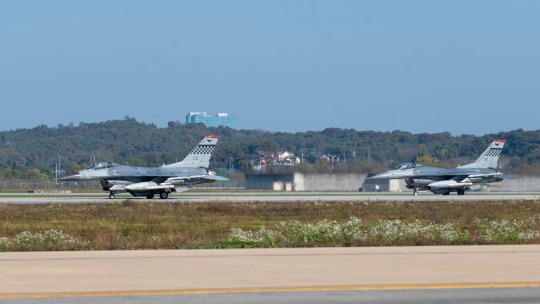

During the five-day event, the U.S. and South Korea will practice the integration of different types of aircraft and different types of operations, including air defense, close air support and emergency air interdiction, according to the ROK Ministry of National Defense.
Another goal will be to improve interoperability and coordination between fourth- and fifth-generation fighters. South Korea has already ordered and started receiving 40 fifth-generation F-35 fighters and intends to buy 25 more in a deal valued at $5.06 billion, which was approved by the U.S. Department of State in September.
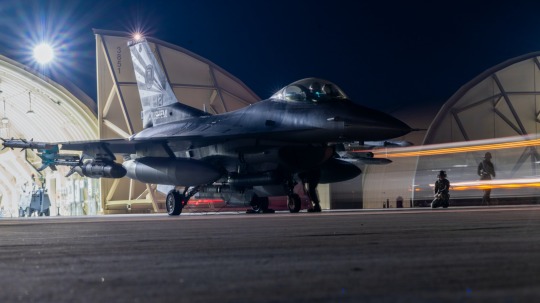
The joint training between the three allies brings the possibility of provoking a North Korean response. Last year's exercise, called 'Watchy Storm', featured about 240 aircraft from the U.S. Air Force, Marine Corps, Navy and Army, along with South Korea and Australia.
North Korea opposed the exercise through its state media. During and after last year's prolonged exercise, Pyongyang tested several short-range ballistic missiles and attempted to launch an intercontinental ballistic missile, which ended in a failure.
The leaders of the U.S. and South Korea have committed to conducting more regular and large-scale exercises together to strengthen the alliance and dissuade North Korea.
North Korea, however, continues to test new missiles. More recently, it fired two short-range ballistic missiles before a bilateral meeting between leader Kim Jong Un and Russian President Vladimir Putin on September 13.

After this meeting, the U.S., South Korea and Japan criticized North Korea for providing military equipment to Russia against Ukraine, warning that such actions violate UN Security Council resolutions and could “significantly increase the human cost of Russia's war of aggression”.
The joint statement released on October 25 by U.S. Secretary of State Anthon Blinken and the foreign ministers of South Korea and Japan stated that Pyongyang is seeking military assistance from Moscow to develop its own capabilities. It also raised concerns about potential exchanges of nuclear or ballistic missile technology between them.

Russia and North Korea denied such exchanges, but satellite images and evaluation by think tanks indicate an increase in rail traffic and suspicions of ammunition shipments from Pyongyang to Moscow.
Tags: Military AviationJoint ExercisesRAAF - Royal Australian Air Force/Royal Australian Air ForceROKAF - Republic of Korea Air Force/South Korea Air ForceUSAF - United States Air Force / U.S. Air ForceWar Zones - Korean Peninsula
Sharing
tweet
Fernando Valduga
Fernando Valduga
Aviation photographer and pilot since 1992, has participated in several events and air operations, such as Cruzex, AirVenture, Dayton Airshow and FIDAE. He has work published in specialized aviation magazines in Brazil and abroad. Uses Canon equipment during his photographic work in the world of aviation.
Related news
MILITARY
Russian Su-57 fighter gets new compact air-to-air missile with a range of 300 km
31/10/2023 - 08:42
AERONAUTICAL ACCIDENTS
FAB C-98 Caravan aircraft makes emergency landing in river in the state of Roraima
30/10/2023 - 22:42
HELICOPTERS
British Army retires its Gazelle helicopters
10/30/2023 - 7:35 PM
HELICOPTERS
Nigerian Defense Delegation examines first T129 ATAK helicopter in Turkey
30/10/2023 - 16:00
MILITARY
Iranian army demonstrates new kamikazes drones with 1 kg warhead
10/30/2023 - 2:00 PM
HELICOPTERS
Spanish Navy receives first Airbus H135 helicopter
10/30/2023 - 11:00
8 notes
·
View notes
Text
Lula Might Already Be Torpedoing Brazil’s G-20 Leadership

The recent G-20 Summit in India ended with Indian Prime Minister Narendra Modi handing the organization’s symbolic gavel of leadership to Brazilian President Luiz Inacio Lula da Silva. Brazil doesn’t officially take charge of the G-20 until December, and Modi has floated the idea of one last virtual meeting among the member states in November while India still controls the agenda. But Lula still used the moment to announce Brazil’s plans for its year at the helm of the group.
Lula’s key focus for Brazil’s G-20 presidency will be ending global hunger by 2030. To do so, he wants to reform multilateral banks and the International Monetary Fund so that they focus on reducing debt burdens in lower-income countries, where money that could go to feeding the population currently goes to servicing debt instead. In addition to a G-20 task force on ending hunger and poverty, he also plans to stand up a second one focused on combating climate change.
That proposed agenda is Lula at his best, highlighting his own personal trajectory as the president who grew up poor, never finished high school, was injured in a manufacturing accident, led union protests and spent time in prison as a pro-democracy protester under Brazil’s dictatorship. He subsequently lived up to that background when he first became president in 2003 by lifting millions of Brazilians out of poverty with the help of some innovative cash-transfer social programs.
Now he wants to take that agenda global. And though his rhetoric can grow heated when railing against multilateral finance, that doesn’t diminish the fact that Lula is a pragmatic negotiator when it comes to developing and implementing policies. That pragmatism is what led him to implement a pro-growth economic agenda in his first two terms as president from 2003 to 2010 and to adopt a similar approach when he returned to office this year.
Unfortunately, Lula’s other comments at the G-20 Summit ensured that nobody paid attention to or cared about his agenda for the coming year. Dismayed by the absence of Chinese President Xi Jinping and Russian President Vladimir Putin in New Delhi, Lula said that he would make sure that geopolitics did not get in the way of next year’s event. He went so far as to promise that Putin—who avoided the G-20 Summit as well as last month’s BRICS Summit in South Africa due to an outstanding warrant by the International Criminal Court over his war crimes in Ukraine—would be able to travel to Brazil next year without the threat of arrest. After the immediate and predictable backlash, Lula was subsequently forced to backtrack, claiming that he didn’t know what the ICC was and had no idea that the arrest warrant might be enforceable in Brazil, which is a signatory to the court’s founding treaty and therefore obligated to comply with its rulings.
Whether or not Lula was aware of the ICC issue, he knows that Brazil’s courts are famously independent and confrontational from personal experience. They jailed Lula himself just a few years ago on corruption charges, and they are currently targeting his predecessor, former President Jair Bolsonaro, in a case in which Lula cannot interfere. Put simply, Lula can’t control the court system the way authoritarian leaders can, and he knows it. For him to promise that Putin wouldn’t be arrested in Brazil wasn’t just an insult to international law, but also a clearly false statement about Brazil’s democracy and separation of powers.
Continue reading.
#brazil#politics#luiz inacio lula da silva#brazilian politics#foreign policy#mod nise da silveira#image description in alt
2 notes
·
View notes
Text
Russian drones pounded grain storage facilities and ports along the Danube River that Ukraine has increasingly relied on as an alternative transport route to Europe, after Moscow broke off a key wartime shipping agreement using the Black Sea. At the same time, a loaded container ship stranded at the Black Sea port of Odesa since Russia’s full-scale invasion more than 17 months ago set sail along a temporary corridor established by Ukraine for merchant shipping. Ukraine’s economy, crunched by the war, is heavily dependent on farming. Its agricultural exports, like those of Russia, are also crucial for world supplies of wheat, barley, sunflower oil and other food that developing nations rely on. A month ago, the Kremlin tore up an agreement brokered last summer by the U.N. and Turkey to ensure safe Ukraine grain exports through the Black Sea. Since then, Kyiv has sought to reroute transport through the Danube and road and rail links into Europe. But transport costs that way are much higher, some European countries have balked at the consequences for local grain prices, and the Danube ports can’t handle the same volume as seaports.
2 notes
·
View notes
Text
Damage reported after train runs over explosive device in Russia's Belgorod Oblast, governor claims

Editor’s note: This is a developing story and is being updated.
A rail line was damaged in Russia’s Belgorod Oblast on May 25 after a cargo train ran over an explosive device planted underneath the tracks, regional governor Vyacheslav Gladkov claimed.
Following an explosion in the Novooskolsky district, the railway’s overhead contact line damaged, Gladkov said. Train traffic has been suspended as a result of the incident.
Gladkov claimed that no one was injured in the alleged attack. The full extent of the damage was not immediately available, as emergency crews are assessing the damage.
Ukraine’s military has not commented on the alleged explosion. The Kyiv Independent cannot verify claims made by Russian officials.
Ukraine’s intelligence agencies as well as Ukrainian partisan movements have previously been involved in sabotage attacks on Russian railways, disrupting the transport of military cargo toward the front line.
Ukraine’s Military Intelligence Agency (HUR) said Ukrainian drone operators destroyed three Russian fuel tanks during a strike on a train moving through occupied areas of Zaporizhzhia Oblast on May 24.
Ukraine’s military currently has a limited presence in Belgorod Oblast, marking a second incursion into Russian territory, following a successful Kursk incursion in August 2024.
Ukraine destroys Russian fuel train in occupied territory, military intelligence says
HUR released video of the strike on its official Telegram channel on May 25, showing a train engulfed in flames.

The Kyiv IndependentThe Kyiv Independent news desk
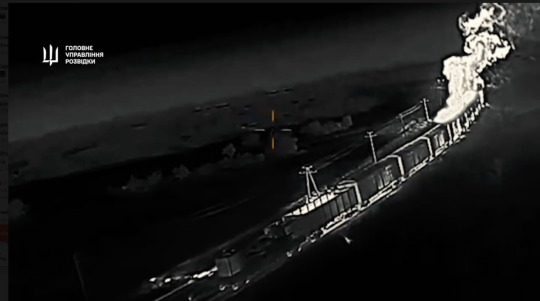
0 notes
Text
The Irreversible Collapse of Global Supply Chains: Causes, Consequences, and the Path Forward
Introduction
The global supply chain, once a well-oiled machine facilitating the seamless movement of goods across borders, is now facing an unprecedented and potentially irreversible collapse. A combination of geopolitical tensions, economic instability, environmental crises, and structural vulnerabilities has pushed the system to a breaking point. Unlike past disruptions—such as the 2008 financial crisis or the COVID-19 pandemic—the current breakdown is not a temporary shock but a systemic failure with long-term consequences. This essay explores the causes of this collapse, its far-reaching impacts, and whether any viable solutions remain.
Causes of the Collapse
1. Geopolitical Fragmentation
The rise of economic nationalism and escalating tensions between major powers (particularly the U.S., China, and Russia) have fractured global trade networks. Sanctions, export controls, and the weaponization of supply chains (e.g., semiconductor bans, energy cutoffs) have disrupted the interdependent model that underpinned globalization. The decoupling of Western economies from China and Russia has led to shortages, inflation, and production halts in critical industries.
2. Energy and Resource Scarcity
The transition away from fossil fuels, coupled with underinvestment in traditional energy infrastructure, has created severe bottlenecks. Europe’s energy crisis following Russia’s invasion of Ukraine demonstrated how reliant supply chains are on stable energy flows. Meanwhile, shortages of rare earth minerals (essential for electronics and green technology) due to export restrictions have further strained manufacturing.
3. Climate Change and Environmental Disasters
Extreme weather events—hurricanes, droughts, floods—are increasingly disrupting transportation and agriculture. The Panama Canal, a critical shipping route, has faced record-low water levels, forcing cargo delays. Similarly, climate-induced crop failures (e.g., wheat in Ukraine, rice in Asia) have triggered food shortages and price spikes.
4. Financial Instability and Debt Crises
Many nations and corporations are drowning in debt, limiting their ability to invest in resilient supply chains. Rising interest rates, bank failures (e.g., Silicon Valley Bank, Credit Suisse), and currency collapses (e.g., Argentina, Turkey) have eroded trust in the global financial system, making trade financing riskier and more expensive.
5. Labor Shortages and Societal Unrest
Aging populations in developed nations and labor strikes (e.g., U.S. rail workers, UK nurses) have compounded supply chain disruptions. Meanwhile, political instability (e.g., protests in France, coups in Africa) has further destabilized production and logistics networks.
Consequences of the Collapse
1. Hyperinflation and Economic Decline
Persistent shortages have driven prices of essential goods—food, fuel, electronics—to unsustainable levels. Central banks’ efforts to curb inflation through rate hikes risk triggering deeper recessions.
2. Food and Medicine Shortages
Countries dependent on imports face famine and healthcare crises. For example, Sri Lanka’s fertilizer ban led to agricultural collapse, while Africa struggles with grain shortages due to the Ukraine war.
3. Technological and Industrial Regression
Semiconductor shortages have stalled auto and electronics production. Without access to key components, industries may be forced to scale back or shut down entirely.
4. Social and Political Instability
Rising costs and unemployment are fueling civil unrest. Governments may resort to protectionism, trade wars, or even military conflicts over resources.
Is Recovery Possible?
The traditional supply chain model—reliant on just-in-time manufacturing, globalization, and cheap energy—is no longer viable. However, some measures could mitigate the damage:
- Regionalization: Shifting production closer to consumer markets (e.g., U.S. reshoring, EU near-shoring).
- Diversification: Reducing dependence on single suppliers (e.g., alternative rare earth sources outside China).
- Technological Adaptation: Automation and AI could offset labor shortages, while 3D printing may decentralize manufacturing.
- Strategic Stockpiling: Governments and firms must maintain reserves of critical goods.
Yet, these solutions require time, investment, and political will—resources that are increasingly scarce. The more likely scenario is a prolonged period of scarcity, economic contraction, and geopolitical realignment.
Conclusion
The collapse of global supply chains is not a temporary disruption but a structural breakdown. The interconnected crises of geopolitics, energy, climate, and finance have pushed the system past its tipping point. While adaptation is possible, a return to the pre-crisis era of hyper-globalization is unlikely. The world must prepare for a new economic reality defined by scarcity, regional blocs, and systemic instability. The question is no longer whether the collapse can be reversed, but how societies will endure its aftermath.
0 notes
Text
Turkey Freight and Logistics Market Analysis, Insight, 2024-2031
BlueWeave Consulting, a leading strategic consulting and market research firm, in its recent study, estimated Turkey Freight and Logistics Market size by value at USD 33.65 billion in 2024. During the forecast period between 2025 and 2031, BlueWeave expects Turkey Freight and Logistics Market size to boom at a steady CAGR of 4.5% reaching a value of USD 45.79 billion by 2031. Turkey's Freight and Logistics Market is driven by several key factors. Its strategic location at the crossroads of Europe and Asia strengthens its role in transcontinental trade. Major government investments in infrastructure projects, including roads, railways, and ports, are enhancing connectivity and efficiency. The rapid growth of e-commerce has increased demand for efficient logistics and last-mile delivery services. Additionally, initiatives like the National Logistics Master Plan and the Customs Modernization Program are streamlining operations and positioning Turkey as a global logistics hub. Technological advancements, such as blockchain and AI adoption, further improve transparency and efficiency in supply chain management.
Sample Request: https://www.blueweaveconsulting.com/report/turkey-freight-and-logistics-market/report-sample
Opportunity – Multimodal Transportation Development and Integration
Turkey's strategic geographic position as a bridge between Europe and Asia has spurred significant advancements in multimodal transportation, integrating road, rail, air, and sea networks to enhance logistics efficiency. Key infrastructure projects like the Baku-Tbilisi-Kars Railway and the Marmaray Tunnel have established seamless rail connections between continents, reducing transit times and costs. The expansion of logistics centers and freight villages further supports intermodal operations, bolstering trade routes and positioning Turkey as a pivotal logistics hub in the region.
Freight Transport Segment Leads Turkey Freight and Logistics Market
The freight transport segment holds the major share in Turkey Freight and Logistics Market, driven by the country's strategic location bridging Europe and Asia. Road transport, in particular, dominates due to Turkey's extensive highway network and ongoing infrastructure investments. This segment's prominence is further bolstered by the nation's growing manufacturing sector and increased international trade activities. Additionally, the government's focus on enhancing multimodal transportation networks has contributed to the segment's robustness.
Impact of Escalating Geopolitical Tensions on Turkey Freight and Logistics Market
Escalating geopolitical tensions have significantly impacted the growth of Turkey Freight and Logistics Market. Conflicts in the Middle East have disrupted energy supplies, leading to increased costs and inflation within Turkey. Trade routes have been affected, hindering exports and imports, and straining Turkish industries. The Russia-Ukraine war has further complicated logistics, disrupting Black Sea trade and increasing transportation costs. In response, Turkey is investing in infrastructure projects, such as new railway lines, to enhance connectivity and position itself as a global logistics hub. Additionally, Turkey has imposed anti-dumping duties on steel imports from several countries to protect domestic industries amid these challenges. These measures aim to mitigate the adverse effects of geopolitical tensions on Turkey's logistics sector.
Competitive Landscape
Turkey Freight and Logistics Market is highly fragmented, with numerous players serving the market. Major companies dominating the market include Ekol Logistics, Borusan Logistics, Netlog Logistics, Mars Logistics, CEVA Logistics, DHL Supply Chain, UPS Turkey, TNT Express, Aras Cargo, Yurtiçi Kargo, and Schenker Arkas. The key marketing strategies adopted by the players are facility expansion, product diversification, alliances, collaborations, partnerships, and acquisitions to expand their customer reach and gain a competitive edge over their competitors in Turkey Freight and Logistics Market.
Contact Us:
BlueWeave Consulting & Research Pvt Ltd
+1 866 658 6826 | +1 425 320 4776 | +44 1865 60 0662
0 notes
Text
Top Custom Software Development Companies in Europe [2025]
European companies are progressively adopting tailored software solutions to work more effectively. For organizations seeking a best-in-class custom software development partner, we present a selection of firms offering comprehensive, end-to-end services. It's vital to recognize the significant difference in the capability of various development providers to deliver genuinely effective custom software.
In order to facilitate the identification of your optimal partner, we have compiled a list of the most reputable custom software development companies in Europe, all of whom possess the capability to develop software solutions tailored to your specific business requisites.
VeryCreatives

VeryCreatives, a recognized leader in design and development, empowers businesses worldwide with exceptional software solutions. Our seasoned professionals excel at attracting more potential users and converting them effectively, leading to robust customer bases, improved retention, and substantial revenue streams for our partners.
Aionys

Aionys, a reputable custom software development company founded in Bulgaria in 2016, offers expert digital product development services to the financial services industry. Their strength lies in their experienced team of software developers, designers, project managers, and QA engineers, who are dedicated to delivering tailored and high-quality solutions.
instinctools

instinctools, with a history spanning over 10 years, specializes in the development of state-of-the-art software solutions designed to address unique business challenges. The company's distinctive methodological approach, coupled with the assembly of an exceptional cadre of technical talent at their Kraków headquarters in Central Europe, solidifies their position as a preeminent software firm in Poland.
Dotcode

For businesses and startups in the EU market, Dotcode, a custom software development company based in Ukraine with offices in the UK and US, specializes in building dedicated development teams. Their platform showcases their successful project history, and they offer IT outsourcing services to enhance existing products and develop scalable tech solutions globally.
Sigma Software

Sigma Software, founded in 2009, serves a wide international clientele, from the US to Australia, with a strong domestic and global presence. They specialize in tailored web and mobile application development and are recognized for their excellent client communication, high-quality code, and a reliable warranty period of 12 months or more.
DIGIWEDO

DIGIWEDO, a custom software development firm with a strong history, specializes in developing Minimum Viable Products (MVPs) and complete digital products for agile companies worldwide. They have expertise in Ruby on Rails for web applications and building feature-rich applications for both iOS and Android. DIGIWEDO has successfully delivered over 300 projects to clients in over 20 countries, managing the entire development lifecycle from the initial idea.
Strypes

Strypes, a software house located in Eindhoven, Netherlands, provides both the establishment and management of dedicated development teams, configured to meet the bespoke requirements of its clientele, and the delivery of end-to-end projects across a range of core sectors, including IT infrastructure, Smart Applications, Remote Diagnostics and Monitoring software, Transport and Mobility, Cloud Solutions, and diverse business verticals.
CodeFirst

CodeFirst, a Custom Software Development Company, employs agile delivery methodologies and leverages its expertise in software development to ensure the provision of premium custom software solutions within the European market. The company is committed to delivering software products within or ahead of stipulated deadlines and at competitive pricing. Each project is regarded as an opportunity to apply the company's extensive experience, innovative solutions, and discerning intuition to consistently surpass client expectations.
#custom software development#software development#software developers#software development in Europe
0 notes
Text
🌍 Popular Locations to set up an ODC in 2025
When establishing an Offshore Development Center (ODC), location is important. Discover which region fits your goals and why these hotspots are leading the offshore development trend. Here's an overview of popular regions:
1. Asia-Pacific: Cost-Effective & Skilled Talent
Vietnam 🇻🇳: The Rising Star
* Cost: Highly competitive (30-50% lower than Western Europe/US).
* Talent: Strong software engineering skills, growing tech ecosystem.
* Tech Stacks: Java, JavaScript, C#/.NET, Python, Go.
* Time Zone: UTC+7.
* Pros: Tax incentives, growing startup scene.
* Cons: Potential communication challenges.
India 🇮🇳: The Largest IT Hub
* Cost: Competitive but rising in major cities.
* Talent: Vast developer pool, strong SaaS industry.
* Tech Stacks: MongoDB, Express.js, React.js, Node.js, Java, C#.
* Time Zone: UTC+5:30.
* Pros: Well-developed tech parks, strong connectivity.
* Cons: Time zone differences, rising salaries.
Philippines 🇵🇭: Customer Support & IT Services
* Cost: Lower than India and Vietnam.
* Talent: Strong English proficiency, established IT infrastructure.
* Tech Stacks: Linux, PHP, Python, MongoDB, Express.js, Angular, Node.js.
* Time Zone: UTC+8:00.
* Pros: High English proficiency.
* Cons: Limited AI/blockchain expertise, BPO focus.
2. Eastern Europe: Strong Tech Talent & EU Compliance
Ukraine 🇺🇦:
* Cost: Higher than Asia.
* Talent: Strong technical skills.
* Tech Stacks: Linux, PHP, Python, JavaScript, MongoDB, .NET.
* Time Zone: UTC+3.
* Pros: Strong tech talent.
* Cons: Geopolitical instability, higher costs.
Poland 🇵🇱: EU-Based Companies
* Cost: Higher than Asia.
* Talent: Access to EU market, strong fintech innovation.
* Tech Stacks: Python, Java, JavaScript, C#, C++, PHP, .NET.
* Time Zone: UTC+2.
* Pros: EU compliance, strong talent pool.
* Cons: Higher costs.
3. Latin America: Best for US-Based Companies
Mexico 🇲🇽: Proximity & Cost-Effectiveness
* Cost: Mid-range.
* Talent: Growing IT sector, good for nearshore/onshore projects.
* Tech Stacks: Python, Java, JavaScript, Ruby on Rails, .NET.
* Time Zone: UTC-6.
* Pros: Proximity to the US, overlapping work hours.
* Cons: Higher costs than some Asian countries.
Brazil 🇧🇷: Largest IT Market in Latin America
* Cost: Mid-range.
* Talent: Strong AI/ML development, large English-speaking workforce.
* Tech Stacks: Python, JavaScript, Kotlin, Ruby on Rails, PHP, Java.
* Time Zone: UTC-3.
* Pros: Large IT market, strong AI/ML capabilities.
* Cons: Complex tax systems.
Choosing the right ODC location requires careful consideration of your specific needs and priorities.
🔗 Check out the full article here: https://saigontechnology.com/blog/offshore-development-center/

#SaigonTechnology#OffshoreDevelopmentCenter#ODC#Vietnam#India#Philippines#EasternEurope#LatinAmerica
0 notes
Text
Global Railroad Ballast Market Restraints Analysis 2025
Global Info Research announces the release of the report “Global Railroad Ballast Market 2025 by Manufacturers, Regions, Type and Application, Forecast to 2031” . The report is a detailed and comprehensive analysis presented by region and country, type and application. As the market is constantly changing, the report explores the competition, supply and demand trends, as well as key factors that contribute to its changing demands across many markets. Company profiles and product examples of selected competitors, along with market share estimates of some of the selected leaders for the year 2025, are provided. In addition, the report provides key insights about market drivers, restraints, opportunities, new product launches or approvals, COVID-19 and Russia-Ukraine War Influence. According to our (Global Info Research) latest study, the global Railroad Ballast market size was valued at US$ million in 2024 and is forecast to a readjusted size of USD million by 2031 with a CAGR of %during review period. According to the data of China Association of Metros, by the end of 2022, 55 cities in mainland China have opened urban rail transit and 308 operating lines. The total length of operating lines is 10287.45 km, ranking first in the world and accounting for 26.2% of the total global mileage. 1080.63 km of new operating lines were added in 2022. By the end of 2022, 545 cities in 78 countries and regions will have opened urban rail transit, with more than 41,386.12 km of operational mileage. Compared to 2021, the total mileage of urban rail transit worldwide would increase by 4,531.92 km, an increase of 11.0%, of which 1,293.45 km of subway mileage, 788.11 km of light rail mileage and 2,450.36 km of tram mileage would increase, accounting for 28.5%, 17.4% and 54.1% of the total increase respectively. This report is a detailed and comprehensive analysis for global Railroad Ballast market. Both quantitative and qualitative analyses are presented by manufacturers, by region & country, by Type and by Application. As the market is constantly changing, this report explores the competition, supply and demand trends, as well as key factors that contribute to its changing demands across many markets. Company profiles and product examples of selected competitors, along with market share estimates of some of the selected leaders for the year 2025, are provided. Market segment by Application:Conventional Rail、High-speed Rail Major players covered: Vulcan、MDU Resources、Caterpillar Inc.、Michels Corporation、Tarmac、Bagforce Aggregates Group Ltd、Cloburn Quarry、Hanso、Rethmann Se & Co. Kg、MQP Key Features:
Global Railroad Ballast market size and forecasts, in consumption value), sales quantity, and average selling prices, 2020-2031
Global Railroad Ballast market size and forecasts by region and country, in consumption value, sales quantity, and average selling prices, 2020-2031
Global Railroad Ballast market size and forecasts, by Type and by Application, in consumption value, sales quantity, and average selling prices, 2020-2031
Global Railroad Ballast market shares of main players, shipments in revenue, sales quantity, and ASP, 2020-2025
The Primary Objectives in This Report Are:
To determine the size of the total market opportunity of global and key countries
To assess the growth potential for Railroad Ballast
To forecast future growth in each product and end-use market
To assess competitive factors affecting the marketplace
This report profiles key players in the global Railroad Ballast market based on the following parameters - company overview, production, value, price, gross margin, product portfolio, geographical presence, and key developments.
The report involves analyzing the market at a macro level: Market Sizing and Segmentation: Report collect data on the overall market size, including the sales quantity (K Units), revenue generated, and market share of different by Type: Granite、Trap Rock、Quartzite、Dolomite、Others Industry Analysis: Report analyse the broader industry trends, such as government policies and regulations, technological advancements, consumer preferences, and market dynamics. This analysis helps in understanding the key drivers and challenges influencing the Railroad Ballast market. Regional Analysis: The report involves examining the Railroad Ballast market at a regional or national level. Report analyses regional factors such as government incentives, infrastructure development, economic conditions, and consumer behaviour to identify variations and opportunities within different markets. Market Projections: Report covers the gathered data and analysis to make future projections and forecasts for the Railroad Ballast market. This may include estimating market growth rates, predicting market demand, and identifying emerging trends. The report also involves a more granular approach to Railroad Ballast: Company Analysis: Report covers individual Railroad Ballast manufacturers, suppliers, and other relevant industry players. This analysis includes studying their financial performance, market positioning, product portfolios, partnerships, and strategies. Consumer Analysis: Report covers data on consumer behaviour, preferences, and attitudes towards Railroad Ballast This may involve surveys, interviews, and analysis of consumer reviews and feedback from different by Application: Conventional Rail High-speed Rail Technology Analysis: Report covers specific technologies relevant to Railroad Ballast. It assesses the current state, advancements, and potential future developments in Railroad Ballast areas. Competitive Landscape: By analyzing individual companies, suppliers, and consumers, the report present insights into the competitive landscape of the Railroad Ballast market. This analysis helps understand market share, competitive advantages, and potential areas for differentiation among industry players. Market Validation: The report involves validating findings and projections through primary research, such as surveys, interviews, and focus groups.
The Main Contents of the Report, includes a total of 15 chapters:
Chapter 1, to describe Optical Tweezers (Mechanobiology Equipment) product scope, market overview, market estimation caveats and base year.
Chapter 2, to profile the top manufacturers of Optical Tweezers (Mechanobiology Equipment), with price, sales, revenue and global market share of Optical Tweezers (Mechanobiology Equipment) from 2020 to 2025.
Chapter 3, the Optical Tweezers (Mechanobiology Equipment) competitive situation, sales quantity, revenue and global market share of top manufacturers are analyzed emphatically by landscape contrast.
Chapter 4, the Optical Tweezers (Mechanobiology Equipment) breakdown data are shown at the regional level, to show the sales quantity, consumption value and growth by regions, from 2020 to 2031.
Chapter 5 and 6, to segment the sales by Type and application, with sales market share and growth rate by type, application, from 2020 to 2031.
Chapter 7, 8, 9, 10 and 11, to break the sales data at the country level, with sales quantity, consumption value and market share for key countries in the world, from 2020 to 2024.and Optical Tweezers (Mechanobiology Equipment) market forecast, by regions, type and application, with sales and revenue, from 2025 to 2031.
Chapter 12, market dynamics, drivers, restraints, trends and Porters Five Forces analysis.
Chapter 13, the key raw materials and key suppliers, and industry chain of Optical Tweezers (Mechanobiology Equipment).
Chapter 14 and 15, to describe Optical Tweezers (Mechanobiology Equipment) sales channel, distributors, customers, research findings and conclusion.
The analyst presents a detailed picture of the market by the way of study, synthesis, and summation of data from multiple sources by an analysis of key parameters. Our report on the Railroad Ballast market covers the following areas:
Railroad Ballast market sizing
Railroad Ballast market forecast
Railroad Ballast market industry analysis
Analyze the needs of the global Railroad Ballastbusiness market
Answer the market level of global Railroad Ballast
Statistics the annual growth of the global Railroad Ballastproduction market
The main producers of the global Railroad Ballastproduction market
Describe the growth factor that promotes market demand
Global Info Research is a company that digs deep into global industry information to support enterprises with market strategies and in-depth market development analysis reports. We provides market information consulting services in the global region to support enterprise strategic planning and official information reporting, and focuses on customized research, management consulting, IPO consulting, industry chain research, database and top industry services. At the same time, Global Info Research is also a report publisher, a customer and an interest-based suppliers, and is trusted by more than 30,000 companies around the world. We will always carry out all aspects of our business with excellent expertise and experience.
0 notes
Text

China releases new images of its next-generation aircraft carrier
Fernando Valduga By Fernando Valduga 04/01/2024 - 11:00 in Military
Chinese state media released new images of China's most advanced aircraft carrier to date, including next-generation launchpads that can catapult a wider range of aircraft from its deck.
First displayed to the public in June 2022, the Fujian was entirely designed and built in-house.
However, to carry out its first tests at sea, the aircraft carrier is larger and technologically more advanced than the Shandong, commissioned in 2019, and the Liaoning, which China bought second hand from Ukraine in 1998 and remodeled internally.
On state television on Tuesday night, the Fujian was seen being towed by a smaller vessel with all three rails of its electromagnetic catapult system visible on its deck.
“In the new year, we will take advantage of every minute, work with determination and strive to be ready for combat as soon as possible,” state television said, citing a Fujian official.
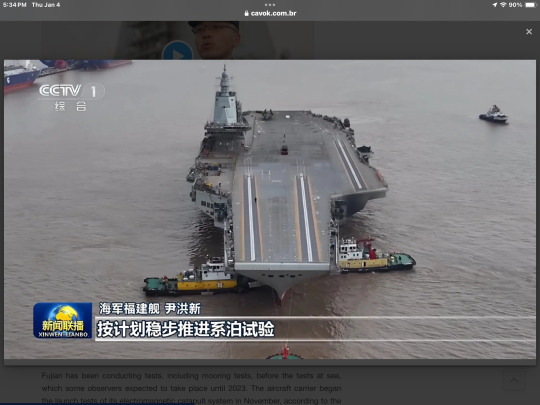
Fujian has been conducting tests, including mooring tests, before the tests at sea, which some observers expected to take place until 2023. The aircraft carrier began the launch tests of its electromagnetic catapult system in November, according to the state-controlled Chinese newspaper, Global Times.
In addition to the Ford Class aircraft carriers, a new class of nuclear-powered aircraft carriers that is being developed for the U.S. Navy, the Fujian will be the only aircraft carrier in the world equipped with the latest Electromagnetic Aircraft Launch System (EMALS). The new images also show a model of the Shenyang J-15 fighter on the back of the flight deck.
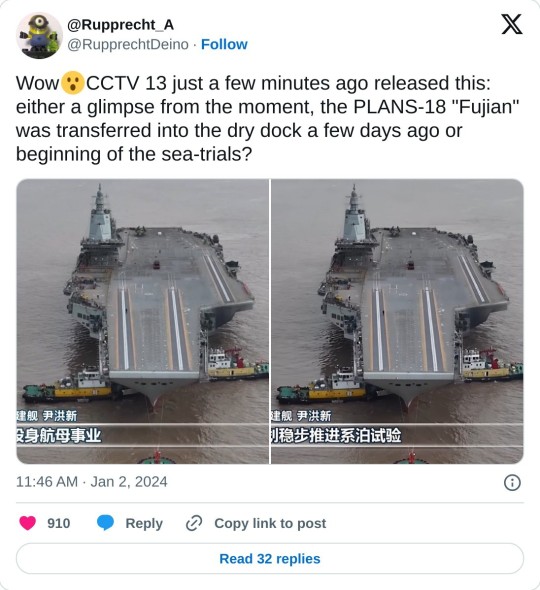
The Chinese version of EMALS can launch more types of aircraft than Shandong or Liaoning, and will also be more reliable and energy efficient, a milestone in the modernization of the Chinese armed forces.
President Xi Jinping repeatedly called for greater combat readiness and technological advances before the 100º anniversary of the founding of the People's Liberation Army (ELP) in 2027. Some senior U.S. military officials previously said that China would launch a military takeover of Taiwan during that year.
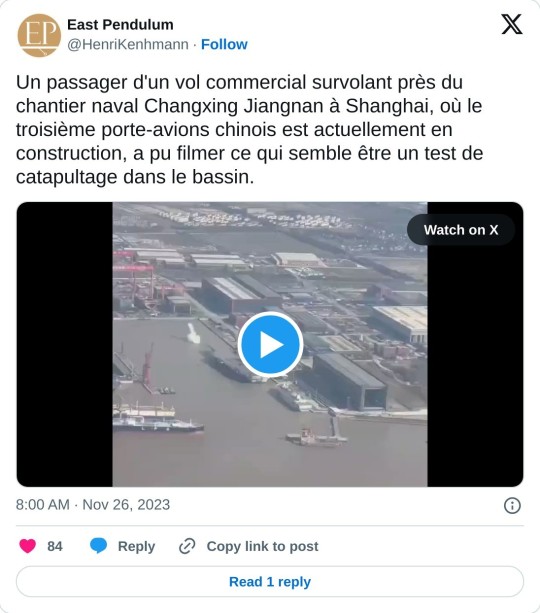
TAP ARROW BUTTON TO VIEW VIDEO ☝️
In the run-up to the presidential and parliamentary elections of January 13, Taiwan reported that China continued its daily military activities in the Taiwan Strait and around the democratically governed island.
Chinese fighters also occasionally crossed the midline of the strait, which previously served as an unofficial barrier, but which Beijing says it does not recognize.
Source: Reuters
Tags: Military AviationChinaFujianPLAN - People's Liberation Army Navy / People's Liberation Army Navyaircraft carrier
Sharing
tweet
Fernando Valduga
Fernando Valduga
Aviation photographer and pilot since 1992, he has participated in several events and air operations, such as Cruzex, AirVenture, Dayton Airshow and FIDAE. He has works published in specialized aviation magazines in Brazil and abroad. He uses Canon equipment during his photographic work in the world of aviation.
Related news
MILITARY
Indonesia plans to modernize its fleet of Su-30 and F-16 aircraft
04/01/2024 - 08:40
MILITARY
US and allies warn Houthis of "consequences" if attacks on ships continue
03/01/2024 - 23:58
AERONAUTICAL ACCIDENTS
Uganda loses one of its new Mi-28 helicopters in an accident
03/01/2024 - 18:20
MILITARY
Norway will send its F-16 fighters to Denmark to train Ukrainian pilots
03/01/2024 - 16:00
COMMERCIAL
Boeing announces full return of the 737 MAX to the Chinese skies
03/01/2024 - 10:00
MILITARY
Aircraft carrier USS Gerald Ford will return from mission in defense of Israel
03/01/2024 - 08:27
5 notes
·
View notes
Text
"The Glorious Guide." From Surah 40, Ghafir, "The Cure for the Dark City."

It was all shits and giggles before I told the world Donald Trump was an illegally sitting President, now that all those extra people are dead in Ukraine after he betrayed them and us and turned off the intel, it's a regular barn burner isn't it?
What do you say to people of Israel and Ukraine and Gaza now? WHHOOOPS???

Actually all one can say is arrest warrants galore for the Kremlin, White House, Congress, Joe Biden and the rest for failing in their civic duties, the time for explanations about why things are not too sweet on this planet right now won't cut it.
We are being steeped in horror right now because bureaucrats and law enforcement officials do not see how serious the neglect of their roles in God's plan and our own has become. As you have seen, for a decade the US Government has been off the rails and there was evidence it should have heeded and this means there are dead persons who should be with us at this time that are no longer here. What can we do now in our prayers and personal reflection time to help us stay on track in spite of the fact our elected officials simply refuse to do it?
This is an ancient problem one the Israelites faced when they were slaves in Egypt. Following is what God told Moses to do about it:
40: 53-56:
"And indeed, We gave Moses ˹true˺ guidance, and made the Children of Israel inherit the Scripture—
a guide and a reminder to people of reason.
So be patient ˹O Prophet˺, ˹for˺ Allah’s promise is certainly true. Seek forgiveness for your shortcomings.1 And glorify the praises of your Lord morning and evening.
Surely those who dispute Allah’s signs—with no proof given to them—have nothing in their hearts but greed for dominance, which they will never attain. So seek refuge in Allah. Indeed, He alone is the All-Hearing, All-Seeing."
Commentary:
We cannot just tell the people of Israel and Ukraine it was just another crazy day in Washington. God says we must act inversely to how we have in the past and think about refuge, our most important humane commitment. Refuge is a global lasting commitment to do what has to be done to ensure no one dies of unnatural causes.
This commitment is integral to the survival of everything on this world and there is no acceptable way to break it. Ladies and gentlemen you are in contempt of God and man and you need to do your jobs and straighten the way between the Kremlin, the White House and the people and living things that are depending on them for long life and happiness and this must be done now, this second, no one is willing to wait any longer nor should they.
God told Muhammad the desire for refuge must dominate all others and we must see this in action at once. On this basis I added it to the commitments all Muslims must observe, identifying the Masjid as a mandatory component of religious practice in the faith. This includes ensuring one is a part of a community in one's proximity and extending its protective influences over the entire world.
We are not obeying God, and people are dying in larger numbers every day. We simply must protect the interests of the Masjid. This is why the Quran was given and why we read it, to develop strong attachments to the same valuable things all of us need. The people that are bullying the rest of us and their friends that are neglecting us, they have no need for these and so they do not even try to understand. Persons who study the Quran, however, cannot refuse to understand.
0 notes